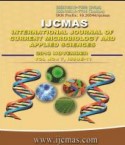


 National Academy of Agricultural Sciences (NAAS)
National Academy of Agricultural Sciences (NAAS)

|
PRINT ISSN : 2319-7692
Online ISSN : 2319-7706 Issues : 12 per year Publisher : Excellent Publishers Email : editorijcmas@gmail.com / submit@ijcmas.com Editor-in-chief: Dr.M.Prakash Index Copernicus ICV 2018: 95.39 NAAS RATING 2020: 5.38 |
The present study was carried out to investigate the effect of solution concentration, immersion time, process temperature and slices thickness on osmotic dehydration of apple slices. The osmotic dehydration characteristics such as water loss (WL), weight reduction (WR) and solid gain (SG) were studied for sugar solution of (50 and 70 ºBrix) at a temperature of (30 °C and 50 °C) for 8 hours of immersion time. After osmotic dehydration, the apple slices were dried in tray dryer for 8 hours at 50 °C and 60 °C temperature. During osmotic dehydration, the maximum value of WL, WR, and SG was found to be 62.9%, 52.0 %, and 11.2 % for 70 ºB sugar solution whereas the minimum value was 52.9 %, 41.21 % and 10.50 % for 50 ºB solution respectively at 50°C after 8 h of osmosis. The drying rate was faster at 60 °C drying temperature for all the sizes osmotically treated apple slices as compared to 50°C drying temperature. This study concludes that several factor such as solution concentration, temperature and immersion time affected affects the osmotic dehydration characteristics. By using the combination of osmotic dehydration followed by drying the losses during storage and handling can be minimized and self-life of the apple fruits could be increased.
 |
 |
 |
 |
 |